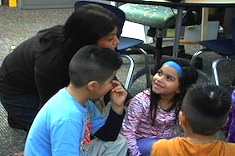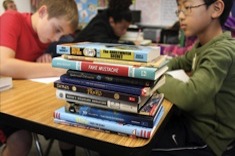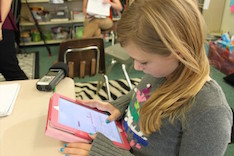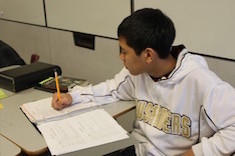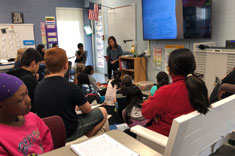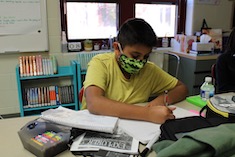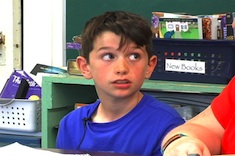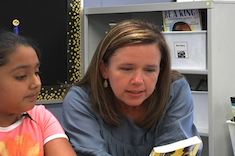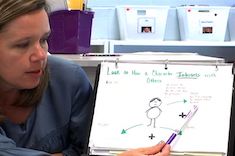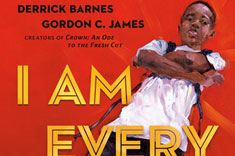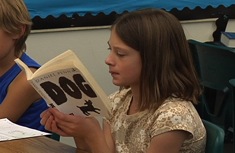5th
Latest Content
Let’s Do It Again, Together
Heather Fisher revisits a whole-school vocabulary routine that she set in motion. In this update, she shares the ways she adjusted to work together as a team rather than fly solo. This might be just the school-wide vocabulary routine you’ve been craving.
Building Bridges (and Confidence): Planning Solid Essays
Melissa Quimby offers time and intentional planning to build students’ confidence and capacity as essay writers.
Informational Poetry
Hannah Tills and Josie Stewart teach students to write informational poetry. They remind us that poetry can serve as a mentor text in many units and does not have to be siloed in its own unit.
Step Into Poetry: Building a Poetry-Conscious Classroom
Joanne Emery has curated a fabulous list of resources and ideas to build a poetry-conscious classroom community.
Weaving Words Throughout the School Year
Joanne Emery rounds up several ideas for embedding vocabulary routines in the school day. She also shares many rich vocabulary resources.
Empowering Students Through Thinking Routines
Jodie Bailey shares practical ways to nourish students’ thinking routines in her math classroom. She is inspired by Peter Liljedahl’s book Building Thinking Classrooms.
Big, Loud, and Slow: Six Strategies for Better Public Speaking
Matt Renwick worked with a speech therapist after having a stroke. Through this process, he realized powerful teaching points to help students become stronger public speakers.
When Reading Practices Drift
When Leigh Anne Eck noticed her students’ reading practices weren’t as robust as she expected, she realized she was the one who had drifted away from key instructional practices. Leigh Anne offers several ways to support students in their independent reading lives.
Kintsugi
Given an assignment to break a china bowl and rebuild it allowed Gretchen Schroeder to engage in the Japanese art of kintsugi. What surprised her were the lessons she learned about growth and innovation in her teaching practice.
Reclaiming Our Time
Vivian Chen gives four steps to adjusting a lesson from the teacher’s guide to reclaim your time and make the lesson more meaningful and engaging to students.
Increasing Engagement During Online Practice Opportunities
Mallory Messenger is intentional about monitoring and supporting cognitive engagement while students use online practice tools. Use her tips so your students are engaged too!
Color Coding: An Organizational Strategy
Leigh Anne Eck gives advice to her middle school writers for collecting research notes.
Sparking Curiosity: Developing Ownership of Learning Through “What If” Questions
Jodie Bailey encourages us to use “What if” questions in all content areas to give students the space to use their innate curiosity to engage in meaningful learning.
Plagued by Plagiarism
Plagiarism is an age-old issue, but with the emergence of AI tools, it’s plaguing our classrooms again. Vivian Chen offers three practical (and essential) approaches when working with writers.
Developing and Listening to Your Inner Voice During Minilessons
Katie Linder reminds us of the importance of listening to (or ignoring) our own inner voices when delivering whole-group instruction. Katie guides us in using our inner voices to make in-the-moment decisions that sharpen lessons.
The Art of Noticing: Have Your Students Played with Language Today?
Stella Villalba noticed her students were so busy writing quickly, they were not paying attention to crafting language. A student, Gabriela, turns to a book and asks for help to make her writing sound like the book. Stella uses this moment to slow down the class and create space to be inspired to write in beautiful ways.
Leveraging AI in Elementary Literacy
David Pittman offers practical and time-saving tips for using AI to help make instructional plans. Need a rubric or discussion questions? David shows how using AI offers a springboard for creating tools for elementary literacy instruction.
Practical Advice for Dealing with Messy Handwriting
Do struggles with handwriting matter? They do when a student can’t even decipher his own words. Katherine Sokolowski confers with fifth grader Sauvi to help him find solutions to the problem.
My Teaching Toolbox (Part 2)
Dana Murphy reminds us that having a teaching toolbox makes planning efficient and effective. In this second installment of a two-part series, Dana offers two additional approaches to delivering strong reading instruction.
Small Shifts That Make a Big Difference
Dana Murphy names two practices that made a big difference in her work as a reading specialist. You may be surprised at the simplicity and smallness that led to powerful gains in her readers.
My Teaching Toolbox (Part 1)
Every now and then we make the classic teaching mistake: assign rather than teach. Dana Murphy curated her favorite teaching tools that help her stay inspired to continually teach students. This is part one of a two-part series.
Holding Space for Counter-Narratives That Honor Communities
Stella Villalba guides us to expand the counter-narrative texts we use in our classrooms. Counter-narrative texts challenge the stereotypes often seen about a group of people, and they celebrate the joy and resilience of a community. Stella provides a list of critical questions that allow us to deeply explore texts, as well as suggestions of books to read.
From a Blank Canvas to a Community Space
Jodie Bailey approaches setting up her math classroom as a blank space with an invitation for students to engage in establishing identity, creativity, and collaboration.
Getting Ready to Read
Dana Murphy encourages us to go beyond teaching students to recognize different genres by helping them establish expectations of genres so they’ll be ready to read.
Emoji Book Talks
Jen Vincent outlines a twist on book talks—the Emoji Book Talks. This is a fast and fun way for students to share books and build their Books to Read lists.
Middle School Reading Routines
Tara Barnett and Kate Mills share ways to establish middle school reading routines. They share two downloads to help support reading routines in all classrooms.
Small-Group Conversations About Independent Reading
Jen Vincent scaffolds conversations to help students discuss their independent reading books in small groups…even when everyone is reading a different book! Download and print a copy of the guide to support students in their small-group conversations.
Developing Independent Writers
Vivian Chen tackles the difficult topic of helping students become independent as writers. She offers tips for before, during, and after writing time to uplift student agency.
Encouraging Agency
Melanie Meehan shares three tips on helping students be independent and productive writers. She also includes a hefty list of craft moves from mentor texts to use while teaching writers.
Writing Graphic Novels
Melanie Meehan shares the immersion process of writing graphic novels with middle grade students. You won’t want to miss the incredible student writing that shows the power of offering choice to young writers.
Browse Content By
Type
Category
- Assessment Tools
- Big Fresh Archives
- Booklists
- Choice Numeracy
- Classroom Design
- Common Core
- Community Building
- Conferring
- Content Literacy
- Digital Literacy
- English Language Learners
- Equity
- Family Relations
- Free Samples
- Guiding Groups
- Leadership
- Literacy Coaches
- Mentor Texts
- Minilessons
- New Teacher Mentors
- Podcasts
- Poetry
- Quote Collections
- Reading Strategies
- Self Care
- Struggling and Striving Learners
- Talking and Listening
- Teacher Study Groups
- Teaching Reading
- Teaching Writing
- Word Study and Vocabulary
Author
- Melissa Quimby
- Nawal Qarooni
- Gwen Blumberg
- Julie Cox
- The Lead Learners
- Hannah Tills
- Josie Stewart
- Ruth Metcalfe
- Mallory Messenger
- Becca Burk
- Jodie Bailey
- Vivian Chen
- Mary Brower
- Tiffany Abbott Fuller
- Stephanie Affinito
- Ruth Ayres
- Leigh Anne Eck
- Heather Fisher
- Shari Frost
- Julie Johnson
- Suzy Kaback
- Gigi McAllister
- Shirl McPhillips
- Melanie Meehan
- Cathy Mere
- Debbie Miller
- Tara Barnett and Kate Mills
- Tammy Mulligan
- Dana Murphy
- Bitsy Parks
- David Pittman
- Brenda Power
- Heather Rader
- Matt Renwick
- Mandy Robek
- Christy Rush-Levine
- Gretchen Schroeder
- Jen Schwanke
- Brian Sepe
- Katherine Sokolowski
- Stella Villalba
- Jennifer Vincent
Grade Level
Choice Literacy Membership
Articles
Get full access to all Choice Literacy article content
Videos
Get full access to all Choice Literacy video content
Courses
Access Choice Literacy course curriculum and training





